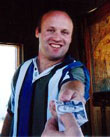|
|
 
|
|
Author
|
Topic: Who Dupes Positives?
|
|
|
|
|
Leo Enticknap
Film God

Posts: 7474
From: Loma Linda, CA
Registered: Jul 2000
|
 posted 01-09-2007 07:59 AM
posted 01-09-2007 07:59 AM





The only colour reversal film sold in 35mm motion picture lengths still available that I know of is Kodak 5285. The only other way you could dupe these prints would be to have an internegative made from your original, and a new print made from that. If you can go to the expense of doing that it could be worth it, because contact-printing release print to reversal is duping two high contrast, unmasked elements, so you will lose a lot of detail in the highlights and shadows. Anyone who has seen 16mm schools films from the '60s and '70s which were shot on Kodachrome, cut into A/B rolls and then release prints made on Kodachrome straight from the original will know what I'm talking about. Secondly, once you've got the interneg, it'll be a lot cheaper to have extra prints made from it, as standard release print stock and processing chemistry can be used, which is much cheaper than reversal.
| IP: Logged
|
|
|
|
Tim Reed
Better Projection Pays

Posts: 5246
From: Northampton, PA
Registered: Sep 1999
|
 posted 01-09-2007 06:30 PM
posted 01-09-2007 06:30 PM




Copyright issues aside, use the lab Derek Maxwell used: Lab Link, NYC. They will go the interneg/pos print route.
Be prepared to pay big $$$, though.
Screen Attractions could do it for you and it would be via a proprietary digital process, but for those short lengths it would cost even more per unit than Lab Link (unless you have an hour or so of film, then the per-ft. cost goes way down).
Also, if you plan on selling prints... there's the matter of music rights, which you have to research. Production libraries consider these new productions, since you are not the original producer. Been there, done that, got the t-shirt. ![[Wink]](wink.gif)
| IP: Logged
|
|
Leo Enticknap
Film God

Posts: 7474
From: Loma Linda, CA
Registered: Jul 2000
|
 posted 01-10-2007 04:05 AM
posted 01-10-2007 04:05 AM





Good point, Tim: I was guessing he just wanted dupes of worn out snipes for use in his own theatre.
About the first thing every lab you ever send anything to does is to ask you to sign a contract. One of the clauses basically says that you (the customer) are either the copyright owner, or have the permission of the copyright owner for the stuff to be copied; and that if any legal shit gets airborne for any reason, it hits your fan, not theirs. If they're being paranoid, they might even demand clearance from the actual copyright owner in advance (as they did, for example, when I sent some regional BBC TV stuff to have a 35mm optical blowup print made from a 16 cut neg and sepmag for a festival screening).
If you send an original 35mm release print of Star Wars to a lab, ask them to strike an interneg and 500 prints from it and ship the lot to an address in Beijing, for example, don't expect them to take your word for it that the job's kosher!
Mind you, about the one good thing about reversal dupes from prints is that the contrast would be so high and the gamma so low that it would probably obliterate the CAP code in the dupe!
| IP: Logged
|
|
|
|
|
|
Leo Enticknap
Film God

Posts: 7474
From: Loma Linda, CA
Registered: Jul 2000
|
 posted 01-10-2007 05:01 PM
posted 01-10-2007 05:01 PM





70-80 feet or so ... in my part of the world, you'd be looking at about the equivalent of around $1.50 a foot for striking an interneg from the original positive, followed by $0.75 for release printing. I simply have no idea what a positive to reversal direct contact print would be. All this assumes a one-light, continuous contact print of both pic and track. If, for whatever reason, a separate track neg is necessary or desirable, you can add a track neg at $1/foot ish, plus possibly rerecording costs.
If you simply want one more print, you might have trouble finding a lab that would want to take on a job that small. If you do decide to go for a reversal dupe, you might have to wait a while until a bigger job comes in and they can do yours in the same batch. As a general rule, 400ft is the smallest length in which the labs can buy raw stock, and for something as unusual as reversal they'd probably have to make up a batch of E6 chemistry specially. It might be worth approaching a lab which specialises in archival work, and is therefore used to dealing with small scale jobs rather than just running off several thousand copies of the latest blockbuster through high speed panel printers. Friends who work in US archives all speak very highly of Colorlab, for example.
| IP: Logged
|
|
|
|
|
|
|
|
|
|
|
|
|
|
|
|
All times are Central (GMT -6:00)
|
|
Powered by Infopop Corporation
UBB.classicTM
6.3.1.2
The Film-Tech Forums are designed for various members related to the cinema industry to express their opinions, viewpoints and testimonials on various products, services and events based upon speculation, personal knowledge and factual information through use, therefore all views represented here allow no liability upon the publishers of this web site and the owners of said views assume no liability for any ill will resulting from these postings. The posts made here are for educational as well as entertainment purposes and as such anyone viewing this portion of the website must accept these views as statements of the author of that opinion
and agrees to release the authors from any and all liability.
|

 Home
Home
 Products
Products
 Store
Store
 Forum
Forum
 Warehouse
Warehouse
 Contact Us
Contact Us




 Printer-friendly view of this topic
Printer-friendly view of this topic










![[Wink]](wink.gif)
![[Razz]](tongue.gif) The local projectionist in the Latin American cinema complained about having to refocus after the trailers and the stock was noisy though the gate.
The local projectionist in the Latin American cinema complained about having to refocus after the trailers and the stock was noisy though the gate.

![[Smile]](smile.gif) I think they still sell prints of it.
I think they still sell prints of it.


